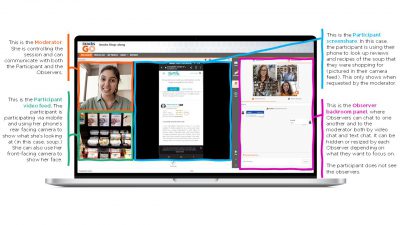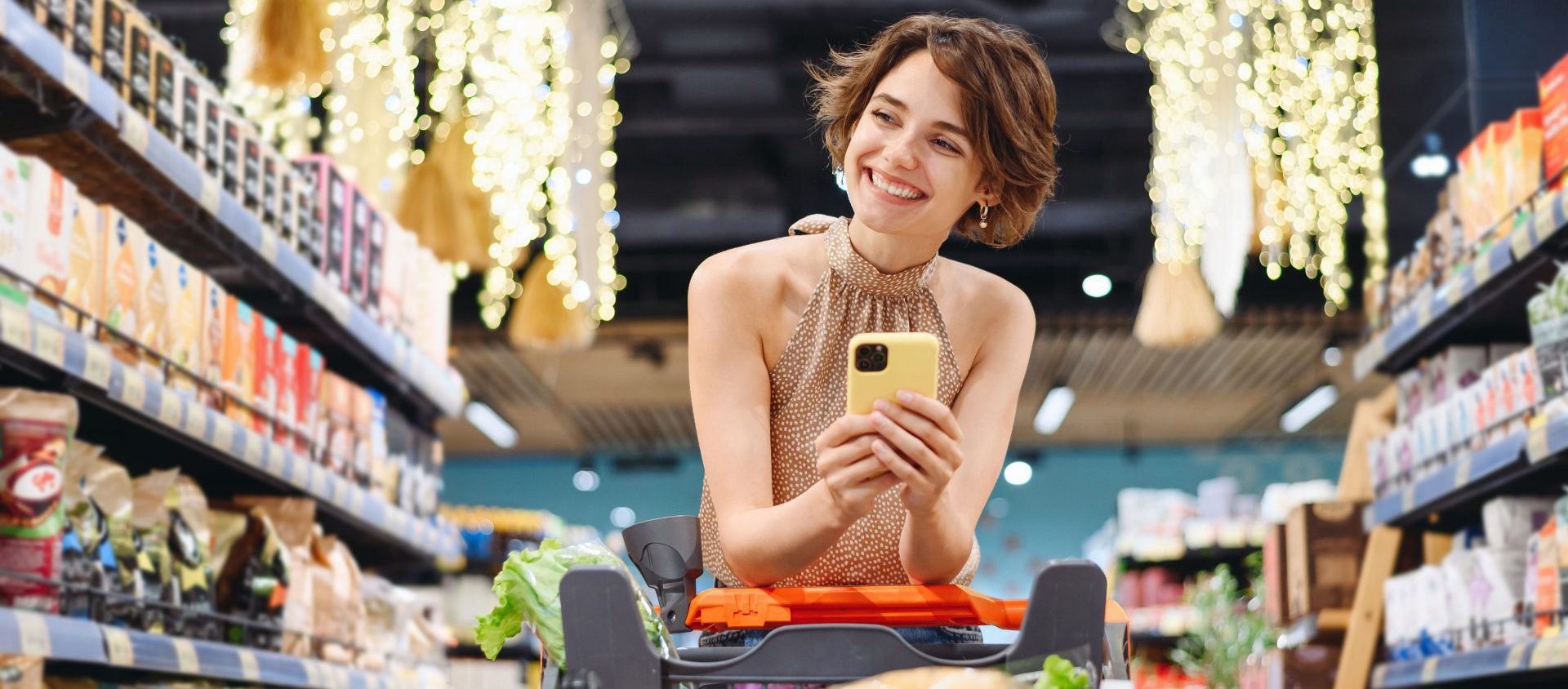Mobile Shopalongs: What they are, and why you can't afford NOT to include them as part of your retail insights strategy.
Historically, shopalong studies have been a popular and effective way for qualitative researchers to gain in-depth insights into consumer shopping behavior. In a shopalong study, a researcher accompanies participants while they shop, observing their actions, interactions, and decision-making process throughout the shopping journey. Traditionally, this would happen in-person with the researcher physically following the shopper around, asking probing questions and making notes or even recording the process. With the recent major improvements in online and mobile-friendly qualitative research technology, there are now many good reasons to design the shopalong study in a way that allows the researcher to accompany the participant shopper virtually as opposed to in-person.
This article will explore the benefits of shopalong studies in which the participant is shopping in-person, and the researcher is observing and interacting with the participant virtually from a remote location.
Do we still need in-store shopalongs? I thought everyone shops online now?!
Long story short, yes - ignoring in-person shopping experiences would be a massive oversight. Shopalongs are an extremely effective way to help retailers gain the knowledge they need to optimize that retail experience in a way that translates to more sales.
Total retail sales last year in the U.S. amounted to approximately $7.1 trillion USD, roughly 85% of which occurred in brick-and-mortar locations. So, while it’s definitely important to stay up-to-date on the latest e-commerce trends and innovations, it’s still incredibly important to optimize the in-store experience in a way that reflects the attitudes and actions of consumers.
Mobile Shopalongs vs. In-person
For the purposes of this article, a mobile shopalong refers to a shopalong study where the participant is physically shopping in-store in a brick-and-mortar location, and the researcher is observing and interacting with them via the participant’s mobile device. This is not to be confused with online shopalongs where you observe an online shopper engaging in ecommerce, which are also very useful but differs greatly in terms of study design strategies and objectives.
Provided you are using a technology which is optimized for qualitative research and has been built with the features and capabilities you need to conduct an effective shopalong, there are many benefits to mobile shopalongs over the traditional 100% in-person method, including:
-
Lack of geographical constraints,
-
Minimizing the Observer Effect,
-
Including more stakeholders in the research,
-
Capturing pre-and post-shopping activity,
-
Capturing the participants’ online activities while they’re shopping in-person.
Benefit #1: Goodbye geographical constraints, and hello cost-savings, broader reach, and greener research.
Mobile shopalongs mean that you can conduct shopalongs in multiple locations without needing to use researchers in several locales or have one research team travel all over the country (or world). The larger, forward-thinking retailers who are likely to invest in qualitative market research projects like shopalongs are highly unlikely to have only one or a few locations. It’s just as unlikely that the customer experience will be identical across all of these locations, so geographical flexibility is key. With mobile shopalongs, your study can benefit from the consistency of having the same research team conduct shopalongs in multiple locations, without the added time and cost of travel. Plus, you will be doing your part to save the environment through greener research!
Benefit #2: Minimizing the observer effect on participants.
As is the case with any form of ethnographic research, the goal of a shopalong is to observe the participants’ natural behavior in a way that helps you understand and optimize the typical shopping experience. People tend to act differently when they’re being observed, whether they intend to or not, and observing virtually through the participant’s mobile phone can mitigate this effect.
Think of yourself – do you tend to act differently when shopping with someone else (let’s say your mother-in-law) than when you’re alone? Maybe you’re more likely to stick to your list than to get distracted (or vice versa!), maybe you’re looking at the person you are with instead of the environment around you, or trying samples or interacting with staff members differently than you would otherwise.
As researchers, no matter how hard we try to convince a participant that we would never judge them (even if we exercise a great demonstration of trust-through-vulnerability and divulge that we, too, have removed our coat to go back for a second sample in hopes that the person giving them out doesn’t recognize us) chances are they will still act a bit differently than if we weren’t there with them.
When we observe virtually through the participant’s mobile phone, this effect can be minimized. The average person now checks their phone 144 times per day – it works out to about 4.5 hours of usage daily. Taking a shopping trip with their phone out is hardly an unusual experience, certainly not as unusual as having a stranger physically follow them around writing things down. They are also less likely to have store staff or fellow customers notice they’re on a shopalong. As annoying as it may be in some instances, the ubiquitousness of public smart phone usage works in our favor when trying to conduct shopalongs in the most natural, discrete way possible.
Benefit #3: Include more stakeholders in the research.
Travel, availability, valuable time, the fact that it’s weird to have a large group of men and women in business attire shuffling behind a shopper who’s pretending not to notice them – there are plenty of reasons that it’s not feasible to invite stakeholders to take part in traditional shopalongs. Mobile shopalongs provide a better opportunity for stakeholder inclusion, which can benefit the research project overall.
Using a dedicated qualitative research platform like itracks Realtime to conduct a shopalong allows you to invite stakeholder observers to participate via the dedicated backroom. This is a space where observers can see the research happening and can communicate with one another and with the moderator, but are completely cut off from view from the participant. Maybe you want to invite someone from the marketing team so they can suggest questions or probes based on what they are seeing. Or maybe you want to invite senior leadership to help them gain empathy for their customer and witness first-hand the value of the research. There are many reasons to invite observers, and conducting your shopalong virtually, using dedicated research software, allows you to do so in a secure, non-invasive way that is conducive to successful research.
Benefit #4: Capturing pre-and post-shopping thoughts and actions.
The decisions shoppers make at the store often start long before they get there. Using an asynchronous discussion board like itracks Board for pre-work allows participants to upload videos, photos, and text responses at their leisure within a set time frame. Maybe they’re going to do some pre-shopping price comparisons and you want them to share their process and the results of their research. In the shopalong demonstration showcased in this webinar, the researcher has the participant capture herself taking a quick fridge inventory before heading to the grocery store.
You may also want to capture what happens after the shopalong. Perhaps the participant went clothes shopping, and you want to observe them trying their new purchases on at home to make sure they look just as good as they did in the store mirrors, or you want them to capture their first time using the newly purchased home goods to ensure they live up to the promises made in-store. Shopalongs using dedicated qualitative research software allow this to do be done seamlessly.
Benefit #5: Capturing the participant’s in-store mobile device usage.
Just because shopping is happening largely in person doesn’t mean that mobile devices don’t play a big part in the process. 68% of shoppers in the U.S. use their smartphones to research products while they’re shopping in-store. This is especially true when shopping for electronics (85%), entertainment (79%), and shoes and clothing (78%). This is why the smartest retailers are developing online environments to integrate with and complement in-person shopping, not just replace it.
Capturing that in-store mobile use is essential to a good understanding of the consumer shopping experience. Using a dedicated qualitative research platform that allows you to see what the participant is seeing in-store through their camera lens, along with sharing what they’re viewing on their screen, is a great way to capture the full experience.
The screenshot below is the observer’s view in itracks Realtime from a grocery store shopalong where the participant was shopping for dinner ingredients. You can see from her camera that she’s currently looking for soup, and via her screenshare, that she’s browsing reviews for the particular soup she’s considering using in her recipe. Encouraging the participant to screenshare whenever they are looking up reviews, price comparisons, checking inventory, looking for coupons, or anything else, will provide much deeper insight into the decision-making process.

Looking for more in-depth mobile shopalong content? Check out the Mobile Shopalong Tips Tricks & How-to's Webinar here!
